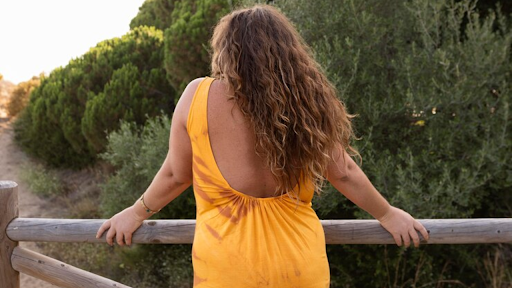Wedding Dress Cleaning: What Causes Fabric Discoloration?

A wedding dress is often one of the most cherished and expensive items in a bride’s wardrobe. Whether it’s passed down through generations or freshly purchased, the desire to preserve its beauty and pristine condition for years to come is natural.
Unfortunately, fabric discoloration can occur over time if the dress isn’t properly cleaned and stored. Understanding the causes of fabric discoloration is essential for preventing damage and ensuring that the wedding dress remains as stunning as the day it was worn.
In this article, we’ll explore the common factors that lead to discoloration and the importance of proper wedding dress cleaning.
1. Exposure to Light
One of the leading causes of fabric discoloration in wedding dresses is prolonged exposure to light. Light, particularly ultraviolet (UV) rays, can break down the fibers in fabric, leading to fading or yellowing. Sunlight, fluorescent lighting, and even artificial lighting in the home can all contribute to this problem. Delicate fabrics like silk, satin, and lace are particularly vulnerable to UV damage, causing the dress to lose its original vibrancy over time.
When storing a wedding dress, it’s crucial to keep it in a dark, cool environment, away from direct sunlight and harsh lighting. Ideally, the dress should be stored in a breathable garment bag that protects it from exposure to light, dust, and pollutants. This will help preserve its color and overall condition.
2. Body Oils and Sweat
When wearing a wedding dress, body oils, sweat, and natural bodily fluids come into direct contact with the fabric. These substances, when left untreated, can lead to discoloration and staining. Sweat, for example, contains salts and minerals that can break down the fabric fibers, causing them to weaken and discolor. Over time, sweat stains can develop into yellowish marks on the fabric, especially under the arms, around the neckline, and in areas where the dress touches the skin.
Body oils, which are naturally produced by the skin, can also leave behind greasy stains on the dress. These oils can oxidize and cause the fabric to yellow or darken. Even if the dress looks clean after the wedding, it’s important to get it professionally cleaned as soon as possible to prevent long-term damage and discoloration.
3. Makeup and Hair Products
Another major contributor to fabric discoloration is makeup and hair products. When a bride applies makeup and hairstyling products, some of these substances can transfer onto the dress, leading to discoloration. Foundations, powders, bronzers, hairspray, and even perfume can leave behind oils, chemicals, and pigments that seep into the fabric, causing it to yellow or stain.
Makeup stains are typically more prominent around the neckline, collar, and sleeves, where the dress comes into close contact with the face and hair. To prevent this, brides should avoid wearing makeup or hairspray during fittings, or take extra care to keep the dress away from such products during the wedding day. Afterward, it’s vital to have the dress professionally cleaned to remove any residual makeup or product traces.
4. Food and Drink Spills
Wedding receptions often involve eating and drinking, which increases the chances of accidental spills. Champagne, wine, cake frosting, and other food and drink items can leave stains on a wedding dress. These substances can cause discoloration, particularly if they contain pigments or sugar. Wine, for instance, contains tannins and anthocyanins, which can cause a permanent stain if not treated promptly.
To prevent discoloration from food and drink spills, it’s essential to act quickly. Blotting the stain with a clean, dry cloth can help absorb excess liquid. However, it’s important not to rub or scrub the fabric, as this can push the stain deeper into the fibers. After the wedding, it’s best to have the dress professionally cleaned to remove any residual stains and prevent permanent discoloration.
5. Improper Cleaning Techniques
Improper cleaning is another common cause of fabric discoloration. Wedding dresses are typically made from delicate fabrics that require specialized cleaning techniques. Standard home washing or dry cleaning methods can be too harsh for certain fabrics, potentially leading to color fading or fabric damage. For example, using bleach or strong detergents on silk or lace can strip the fabric of its original color, causing yellowing or dullness.
It’s crucial to choose professional wedding gown cleaning services. The service providers will use the right cleaning methods, such as gentle dry cleaning or specialized hand-washing, to ensure that the dress remains in its best condition. Additionally, professional cleaners have the expertise to handle stubborn stains without causing further damage to the fabric.
6. Storage Conditions
After the wedding, improper storage conditions can significantly contribute to fabric discoloration. Storing the dress in an environment that is too humid, warm, or exposed to pollutants can lead to yellowing, mold growth, or other forms of fabric damage. Humidity and heat can break down the fibers of the dress, causing them to discolor or degrade over time. Additionally, storing the dress in a plastic bag or airtight container can trap moisture, leading to mildew and stains.
To preserve the color and quality of a wedding dress, it’s best to store it in a cool, dry place with controlled humidity. A well-ventilated, dark room is ideal for keeping the dress safe from exposure to light, moisture, and pollutants. A wedding dress preservation kit can help protect the fabric from dust and physical damage while ensuring the dress stays in optimal condition.
7. Environmental Factors
Environmental factors such as pollution, smoke, and airborne chemicals can also contribute to fabric discoloration. Pollutants in the air can cling to the fabric of the dress, causing it to become dull or discolored over time. Cigarette smoke, in particular, contains chemicals that can yellow the fabric, leaving behind an unpleasant odor as well.
The best way to prevent environmental discoloration is to keep the dress in a controlled environment and away from any sources of pollution. When transporting the dress, it’s important to keep it in a protective garment bag to shield it from contaminants in the air.
Conclusion
Discoloration of a wedding dress is a common issue that can result from several factors, including exposure to light, body oils, sweat, makeup, spills, improper cleaning, storage conditions, and environmental pollutants. To preserve the integrity and beauty of a wedding dress, it’s essential to take proper care during and after the wedding day. This includes timely cleaning, correct storage, and protecting the dress from potential damage. By understanding the causes of fabric discoloration and following best practices for care, brides can ensure their wedding dress remains as beautiful as the memories associated with it.






